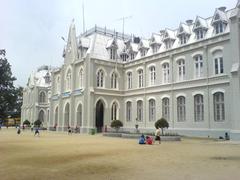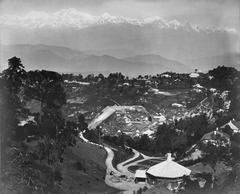Padmaja Naidu Himalayan Zoological Park: Visiting Hours, Tickets, and Travel Guide
Date: 15/06/2025
Introduction
Perched atop Jawahar Parbat in Darjeeling, West Bengal, the Padmaja Naidu Himalayan Zoological Park stands as India’s highest-altitude zoo and a beacon of high-altitude wildlife conservation. Established in 1958 and named after Padmaja Naidu—a freedom fighter and former Governor of West Bengal—the park is renowned for its commitment to preserving rare Himalayan species and promoting ecological awareness. Spanning approximately 68 acres at an elevation of 2,134 meters (7,000 feet), the park authentically replicates the natural habitats of the Eastern Himalayas, making it an essential destination for wildlife enthusiasts and eco-conscious travelers.
This detailed guide covers the park’s history, conservation impact, visitor essentials, and nearby attractions, ensuring you have all the practical information needed for a rewarding experience in Darjeeling.
History and Conservation Significance
Padmaja Naidu Himalayan Zoological Park was established as a pioneering step towards the protection of Himalayan fauna (official Darjeeling tourism website). Its unique location allows it to house and breed species adapted to cold, mountainous conditions—most notably the endangered red panda and snow leopard. Over the decades, the park has developed into a hub for research, education, and internationally recognized captive breeding programs, particularly for the snow leopard and red panda (WWF India).
Conservation Milestones
- Red Panda Conservation: The park’s flagship program, launched in the early 1990s, has made remarkable strides. With fewer than 8,000 red pandas remaining in the wild, the zoo’s breeding and release initiatives—including successful reintroductions to Singalila National Park—have set a global standard (Indian Masterminds).
- Snow Leopard Breeding: Home to India’s first internationally recognized snow leopard conservation program, the park has been pivotal in increasing captive populations and genetic diversity.
- Wildlife Biobank: In collaboration with the Centre for Cellular and Molecular Biology, the zoo hosts India’s first zoo-based wildlife biobank, preserving genetic material for endangered Himalayan species to aid in future research and restoration efforts.
Visitor Information
Visiting Hours
- Open: Daily from 9:30 AM to 4:30 PM (last entry at 4:00 PM)
- Closed: Thursdays and select public holidays for maintenance
Note: Hours may vary with seasons and special events. Confirm via the official website before visiting.
Ticket Prices
- Indian Adults: ₹60
- Indian Children (5–12 years): ₹30
- Foreign Nationals: ₹200 (adults), ₹100 (children)
- Students/Senior Citizens: ₹30 (with valid ID)
- Children below 5 years: Free
- Camera Fee: ₹10 per camera
- Combined Ticket: Includes entry to the Himalayan Mountaineering Institute and Bengal Natural History Museum
Check the official website or call +91-354-2253709 for the latest ticket updates.
Location and Accessibility
- Address: Jawahar Parbat, Darjeeling, West Bengal
- From Mall Road/Chowrasta: 2–3 km (10–15 min by taxi or 25–30 min walk)
- Transport Options: Taxis, battery-operated carts (seasonal), and scenic walking routes
- Parking: Available near the main gate
- Wheelchair Access: Available; some steep areas may require assistance
Facilities and Amenities
- Restrooms and drinking water stations
- In-house canteen for snacks and refreshments
- Souvenir and bookshop at the entrance
- Benches, shaded rest areas, and rain shelters
- Detailed maps and signage throughout the park
- Raincoat and traditional attire rental for photo opportunities
Plastic bags and bottles are prohibited to protect the environment.
Key Attractions and Experiences
Rare and Endangered Species
The zoo specializes in Himalayan species, including:
- Red Panda: The park is a leading center for red panda conservation and breeding. Visitors can observe these charismatic mammals in enclosures designed to emulate their bamboo forest habitat.
- Snow Leopard: The snow leopard enclosure, recognized for its naturalistic landscaping, provides opportunities to spot this elusive predator.
- Himalayan Wolf, Black Bear, and Carnivores: The zoo also houses Himalayan wolves, leopards, and tigers, all maintained in secure, semi-natural habitats.
- Herbivores: Species such as the Himalayan tahr, blue sheep, sambar deer, barking deer, and yaks can be seen.
- Aviary: Home to Himalayan birds, including monals, tragopans, pheasants, and exotic waterfowl.
Thematic and Educational Zones
- Conservation Breeding Center: While not open to the public, this facility is core to the zoo’s mission, supporting breeding of red pandas, snow leopards, and Himalayan wolves.
- Educational Displays: Informative placards detail each species’ habitat and conservation status.
- Guided Tours: Available for groups and during special events; otherwise, signage supports self-guided exploration.
- Zoological Museum and Animal Biobank: Recent additions include a museum and India’s first zoo-based biobank, enhancing educational and research capabilities.
Himalayan Mountaineering Institute (HMI) and Bengal Natural History Museum
Located within the same complex, the Himalayan Mountaineering Institute features exhibits on mountaineering history, Himalayan expeditions, and artifacts related to Tenzing Norgay and Sir Edmund Hillary. The Bengal Natural History Museum showcases regional flora and fauna through taxidermy, photographs, and educational materials. Admission is included with your zoo ticket.
Practical Tips for Visitors
- Best Time to Visit: March–June and September–November for pleasant weather and active animal sightings.
- Recommended Duration: Allocate 2–3 hours to fully explore the zoo and adjacent attractions.
- Dress: Wear comfortable shoes for hilly terrain and dress in layers; Darjeeling weather is unpredictable.
- Photography: Allowed (no flash); professional cameras require a small additional fee.
- Responsible Tourism: Do not feed or disturb animals; use bins for waste; keep noise low; follow staff instructions.
Health, Safety, and Accessibility
- First Aid: Basic services available onsite.
- Altitude Awareness: At 2,134 meters, take breaks and stay hydrated.
- Mobility: Most areas are accessible; some slopes may require assistance.
How to Reach
- By Air: Bagdogra Airport (~90 km); taxis and shared jeeps available to Darjeeling.
- By Train: New Jalpaiguri (NJP) station (~70 km); taxis and jeeps connect to Darjeeling.
- By Road: Well-connected to Siliguri, Kalimpong, and Gangtok by road.
Notable Nearby Attractions
- Darjeeling Himalayan Railway (Toy Train): A UNESCO World Heritage Site
- Tiger Hill: Renowned for sunrise views of Everest and Kanchenjunga
- Batasia Loop: Scenic railway spiral with panoramic vistas and a war memorial
- Peace Pagoda: Serene Buddhist monument with sweeping views
- Chowrasta Mall: Heart of Darjeeling, ideal for shopping and local cafes
- Darjeeling Botanical Garden: Showcases Himalayan flora
Frequently Asked Questions (FAQs)
Q: What are the Padmaja Naidu Himalayan Zoological Park visiting hours?
A: Open daily from 9:30 AM to 4:30 PM (closed Thursdays).
Q: How much are the tickets?
A: Indian adults ₹60, children (5–12) ₹30, foreign nationals ₹200, children under 5 free.
Q: Are cameras allowed?
A: Yes, with a nominal fee of ₹10 per camera.
Q: Is the zoo wheelchair accessible?
A: Yes, though steep paths may require assistance.
Q: Can I combine my visit with other attractions?
A: Yes, the ticket includes the Himalayan Mountaineering Institute and Bengal Natural History Museum.
Summary and Recommendations
The Padmaja Naidu Himalayan Zoological Park serves as a vital center for Himalayan wildlife conservation, education, and eco-tourism, blending scientific achievement with cultural heritage. Its internationally recognized breeding programs, innovative biobank, and community outreach reinforce its role as a leader in biodiversity preservation.
Visitors enjoy thoughtfully curated exhibits, scenic vistas, and seamless access to Darjeeling’s most significant historical sites. For the best experience, plan your visit during the spring or autumn, explore the adjoining museums, and support conservation by following responsible tourism guidelines.
Stay updated by consulting the official resources, downloading the Audiala app for travel assistance, and engaging with community initiatives.
Official Resources and Further Reading
- Padmaja Naidu Himalayan Zoological Park Official Website
- Darjeeling Tourism Portal
- WWF India Snow Leopard Conservation
- Help The Tourists: Park Overview
- Red Panda Conservation: Indian Masterminds
- Kanchenjunga Holidays: Visitor Guide
- Darjeeling Offbeat: Travel Tips
- Government Portal: Visitor Information




